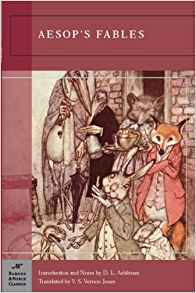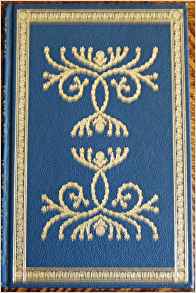-
Aesop's Fables
Aesop
eBook (, April 23, 2017)Instead of memorizing vocabulary words, work your way through an actual well-written novel. Even novices can follow along as each individual English paragraph is paired with the corresponding Portuguese paragraph. It won't be an easy project, but you'll learn a lot
-
Aesop's Fables
Aesop
Paperback (CreateSpace Independent Publishing Platform, Jan. 6, 2014)This is a collection of tales from the Greek story teller, Aesop. Aesop was a slave in ancient Greece. He was a keen observer of both animals and people. Most of the characters in his stories are animals, some of which take on human characteristic and are personified in ways of speech and emotions. However, the majority of his character retain their animalistic qualities; tortoise are slow, hares are quick, tigers eat bird, etc. Aesop uses these qualities and natural tendencies of animals to focus on human traits and wisdom. Each fable has an accompanying moral to be learned from the tale.
-
Aesop's Fables
Aesop Aesop, Ian Timberland
language (, May 14, 2020)Aesop, the slave and storyteller of ancient Greece, with humor, irony, and commonsense philosophy, illuminates the follies, frailties, and resilience of humankind to this day with hi stories. Numerous fables appearing under his name were gathered across the centuries and in many languages in a storytelling tradition that continues to this day. In many of these tales animals speak and have human characteristics. The body of work identified as Aesop’s Fables was transmitted by a series of authors writing in both Greek and Latin. Aesop’s Fables continued to be revised and translated through the ensuing centuries, with the addition of material from other cultures. With a surge in scholarly interest beginning toward the end of the 20th century, some attempt has been made to determine the nature and content of the very earliest fables which may be most closely linked to the historic Aesop.These simple tales embody truths so powerful, the titles of the individual fables - the fox and the grapes, the dog in the manger, the wolf in sheep's clothing and many others - have entered the languages and idioms of most European tongues.
-
Aesop's Fables
Aesop
Paperback Bunko (Dover Publications, March 15, 1741)Excellent Book
-
Aesop's Fables
Aesop
Hardcover (Engage Books, Oct. 1, 2015)In this collection of over three hundred fables, Aesop masterfully unravels the morals behind every action in human nature. Included are the favouries "The Shepherd-Boy and the Wolf," "The Tortoise and the Hare," and "The Dog and the Shadow." These time-honoured morals teach children that persuasion is better than force, slow but steady wins the race, and to look before you leap. A fable is often thought of as a story intended to help children learn wholesome values and how to behave within society at large. However, in ancient Greece, fables were used as a means of persuasion, as the moral of a fable can be delivered in an indirect manner. This helped philosophers such as Plato, Aristophanes, and Socrates argue controversial points without offending their audience.
-
Aesop's Fables
AESOP, Rochelle Larkin
Paperback (Heinle ELT, March 25, 2003)An illustrated collection of twenty-four Aesop fables selected from those populated only by animals, arranged in categories such as lion fables, fox fables, and wolf fables.
-
Aesop's Fables
Aesop, Taylor Anderson, G. K. Chesterton
Paperback (CreateSpace Independent Publishing Platform, Nov. 25, 2017)Aesop's Fables, or the Aesopica, is a collection of fables credited to Aesop, a slave and storyteller believed to have lived in ancient Greece between 620 and 564 BC. Of diverse origins, the stories associated with his name have descended to modern times through a number of sources and continue to be reinterpreted in different verbal registers and in popular as well as artistic media. The fables originally belonged to the oral tradition and were not collected for some three centuries after Aesop's death. By that time a variety of other stories, jokes and proverbs were being ascribed to him, although some of that material was from sources earlier than him or came from beyond the Greek cultural sphere. The process of inclusion has continued until the present, with some of the fables unrecorded before the later Middle Ages and others arriving from outside Europe. The process is continuous and new stories are still being added to the Aesop corpus, even when they are demonstrably more recent work and sometimes from known authors. Manuscripts in Latin and Greek were important avenues of transmission, although poetical treatments in European vernaculars eventually formed another. On the arrival of printing, collections of Aesop's fables were among the earliest books in a variety of languages. Through the means of later collections, and translations or adaptations of them, Aesop's reputation as a fabulist was transmitted throughout the world. Initially the fables were addressed to adults and covered religious, social and political themes. They were also put to use as ethical guides and from the Renaissance onwards were particularly used for the education of children. Their ethical dimension was reinforced in the adult world through depiction in sculpture, painting and other illustrative means, as well as adaptation to drama and song. In addition, there have been reinterpretations of the meaning of fables and changes in emphasis over time.
-
Aesop's Fables by Aesop
None
Audio CD (Blackstone Audiobooks, April 1, 1884)None
-
Aesop's Fables
Aesop
Paperback (Canterbury Classics, March 15, 1736)None
-
Aesop's Fables Barnes & Noble Classics Series by Aesop
None
Mass Market Paperback (Barnes & Noble Classics, March 24, 1862)100% Satisfaction is Guaranteed! There are no problems in page content and in the paper. There are no problems except minor faults. For New condition books in our store; You will be the first user. You will be the first to open the book cover. For Used condition books in our store; It shows signs of wear from consistent use, but it remains in good condition and works perfectly. All pages and cover are intact , but may have aesthetic issues such as price clipping, nicks, scratches, and scuffs. Pages may include some notes and highlighting. For all our books; Cargo will be delivered in the required time.
-
Aesop's Fables
Aesop
Mass Market Paperback (Signet Classics, Jan. 1, 1972)None
-
Aesop's Fables
None
Unknown Binding (International Collectors Library, Jan. 1, 1968)This item has very limited amount of shelf ware. Small stain on the front binding and back binding.